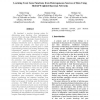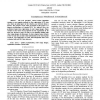108
Voted
SC
2005
ACM
15 years 6 months ago
2005
ACM
We present the development and use of a novel distributed geohazard modeling environment for the analysis and interpretation of large scale earthquake data sets. Our work demonstr...
131
click to vote
SAC
2005
ACM
15 years 6 months ago
2005
ACM
Simulations of complex scientific phenomena involve the execution of massively parallel computer programs. These simulation programs generate large-scale multidimensional data set...
107
Voted
ICDM
2005
IEEE
15 years 6 months ago
2005
IEEE
Multivariate time series (MTS) data sets are common in various multimedia, medical and financial application domains. These applications perform several data-analysis operations ...
142
Voted
CSB
2005
IEEE
15 years 6 months ago
2005
IEEE
We developed a machine learning system for determining gene functions from heterogeneous sources of data sets using a Weighted Naive Bayesian Network (WNB). The knowledge of gene ...
CBMS
2005
IEEE
15 years 6 months ago
2005
IEEE
Current research in biomedical informatics involves analysis of multiple heterogeneous data sets. This includes patient demographics, clinical and pathology data, treatment histor...
102
Voted
CAMP
2005
IEEE
15 years 6 months ago
2005
IEEE
—All sciences, including astronomy, are now entering the era of information abundance. The exponentially increasing volume and complexity of modern data sets promises to transfor...
102
Voted
SENSYS
2006
ACM
15 years 6 months ago
2006
ACM
Science is increasingly driven by data collected automatically from arrays of inexpensive sensors. The collected data volumes require a different approach from the scientists'...
123
Voted
SSDBM
2006
IEEE
15 years 6 months ago
2006
IEEE
The detection of correlations between different features in high dimensional data sets is a very important data mining task. These correlations can be arbitrarily complex: One or...
84
Voted
IV
2006
IEEE
15 years 6 months ago
2006
IEEE
The information revolution is creating and publishing vast data sets, such as records of business transactions, environmental statistics and census demographics. In many applicati...
IROS
2006
IEEE
15 years 6 months ago
2006
IEEE
- The ICP (Iterative Closest Point) algorithm remains a very popular method for the registration of 3D data sets, when an initial guess of the relative pose between them is known. ...




